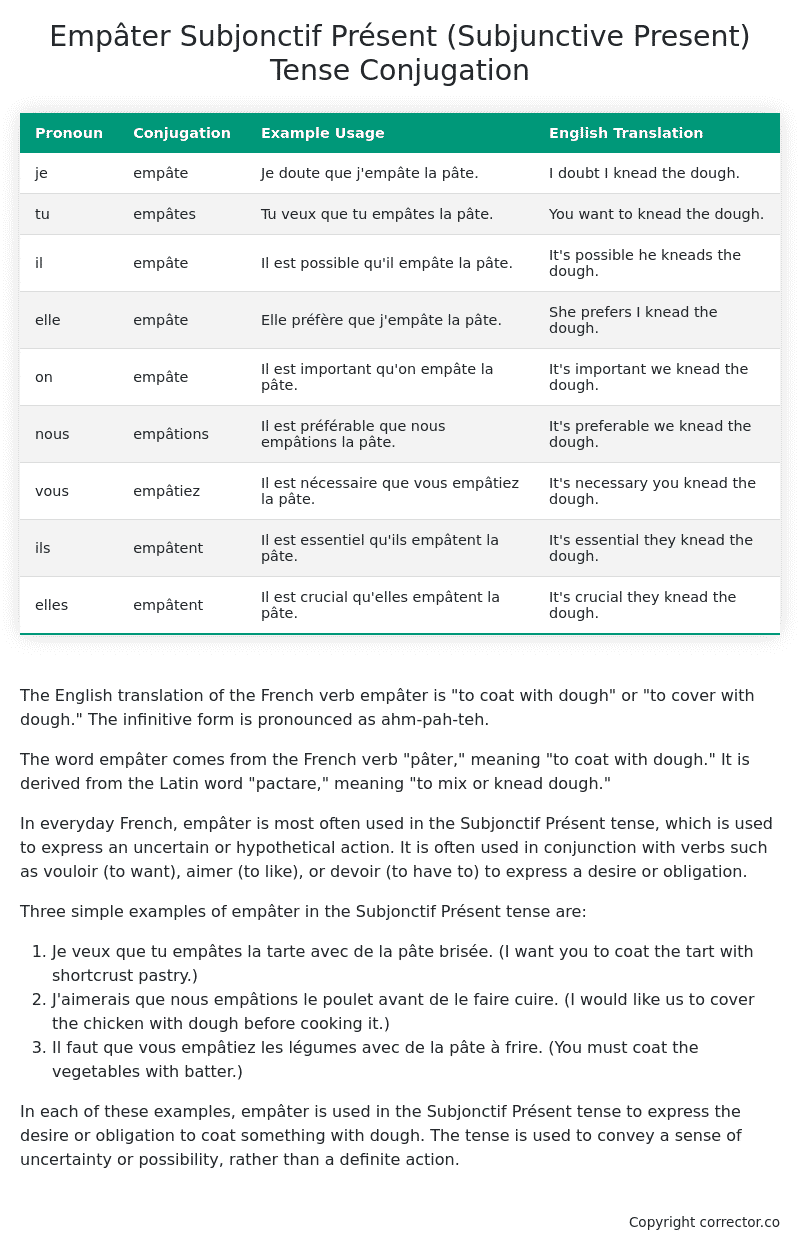Subjonctif Présent (Subjunctive Present) Tense Conjugation of the French Verb empâter
Introduction to the verb empâter
The English translation of the French verb empâter is “to coat with dough” or “to cover with dough.” The infinitive form is pronounced as ahm-pah-teh.
The word empâter comes from the French verb “pâter,” meaning “to coat with dough.” It is derived from the Latin word “pactare,” meaning “to mix or knead dough.”
In everyday French, empâter is most often used in the Subjonctif Présent tense, which is used to express an uncertain or hypothetical action. It is often used in conjunction with verbs such as vouloir (to want), aimer (to like), or devoir (to have to) to express a desire or obligation.
Three simple examples of empâter in the Subjonctif Présent tense are:
- Je veux que tu empâtes la tarte avec de la pâte brisée. (I want you to coat the tart with shortcrust pastry.)
- J’aimerais que nous empâtions le poulet avant de le faire cuire. (I would like us to cover the chicken with dough before cooking it.)
- Il faut que vous empâtiez les légumes avec de la pâte à frire. (You must coat the vegetables with batter.)
In each of these examples, empâter is used in the Subjonctif Présent tense to express the desire or obligation to coat something with dough. The tense is used to convey a sense of uncertainty or possibility, rather than a definite action.
Table of the Subjonctif Présent (Subjunctive Present) Tense Conjugation of empâter
| Pronoun | Conjugation | Example Usage | English Translation |
|---|---|---|---|
| je | empâte | Je doute que j’empâte la pâte. | I doubt I knead the dough. |
| tu | empâtes | Tu veux que tu empâtes la pâte. | You want to knead the dough. |
| il | empâte | Il est possible qu’il empâte la pâte. | It’s possible he kneads the dough. |
| elle | empâte | Elle préfère que j’empâte la pâte. | She prefers I knead the dough. |
| on | empâte | Il est important qu’on empâte la pâte. | It’s important we knead the dough. |
| nous | empâtions | Il est préférable que nous empâtions la pâte. | It’s preferable we knead the dough. |
| vous | empâtiez | Il est nécessaire que vous empâtiez la pâte. | It’s necessary you knead the dough. |
| ils | empâtent | Il est essentiel qu’ils empâtent la pâte. | It’s essential they knead the dough. |
| elles | empâtent | Il est crucial qu’elles empâtent la pâte. | It’s crucial they knead the dough. |
Other Conjugations for Empâter.
Le Present (Present Tense) Conjugation of the French Verb empâter
Imparfait (Imperfect) Tense Conjugation of the French Verb empâter
Passé Simple (Simple Past) Tense Conjugation of the French Verb empâter
Passé Composé (Present Perfect) Tense Conjugation of the French Verb empâter
Futur Simple (Simple Future) Tense Conjugation of the French Verb empâter
Futur Proche (Near Future) Tense Conjugation of the French Verb empâter
Plus-que-parfait (Pluperfect) Tense Conjugation of the French Verb empâter
Passé Antérieur (Past Anterior) Tense Conjugation of the French Verb empâter
Futur Antérieur (Future Anterior) Tense Conjugation of the French Verb empâter
Subjonctif Présent (Subjunctive Present) Tense Conjugation of the French Verb empâter (this article)
Subjonctif Passé (Subjunctive Past) Tense Conjugation of the French Verb empâter
Subjonctif Imparfait (Subjunctive Imperfect) Tense Conjugation of the French Verb empâter
Subjonctif Plus-que-parfait (Subjunctive Pluperfect) Tense Conjugation of the French Verb empâter
Conditionnel Présent (Conditional Present) Tense Conjugation of the French Verb empâter
Conditionnel Passé (Conditional Past) Tense Conjugation of the French Verb empâter
L’impératif Présent (Imperative Present) Tense Conjugation of the French Verb empâter
L’infinitif Présent (Infinitive Present) Tense Conjugation of the French Verb empâter
Struggling with French verbs or the language in general? Why not use our free French Grammar Checker – no registration required!
Get a FREE Download Study Sheet of this Conjugation 🔥
Simply right click the image below, click “save image” and get your free reference for the empâter Subjonctif Présent tense conjugation!

Empâter – About the French Subjonctif Présent (Subjunctive Present) Tense
Formation of the Subjonctif Présent
Common Everyday Usage Patterns
Interactions with Other Tenses
Summary
I hope you enjoyed this article on the verb empâter. Still in a learning mood? Check out another TOTALLY random French verb conjugation!


